Fun, colorful, and easy to use, the iBert bike seat is a great child bike seat for shorter jaunts around the neighborhood. Attaching to the stem of your bike (just below the handlebars), the iBert comfortably positions your 1 to 3-year-old front and center on the bike, providing a shared and memorable biking experience.
As one of the most popular front-mounted child bike seat in the US, the iBert is a trusted name amongst parents and outdoor enthusiasts, but how does it compare to newer, and lesser-known front-mounted seats? After testing 19 different front-mounted seats, we set out to see if the iBert can still hold its own against the newcomers.
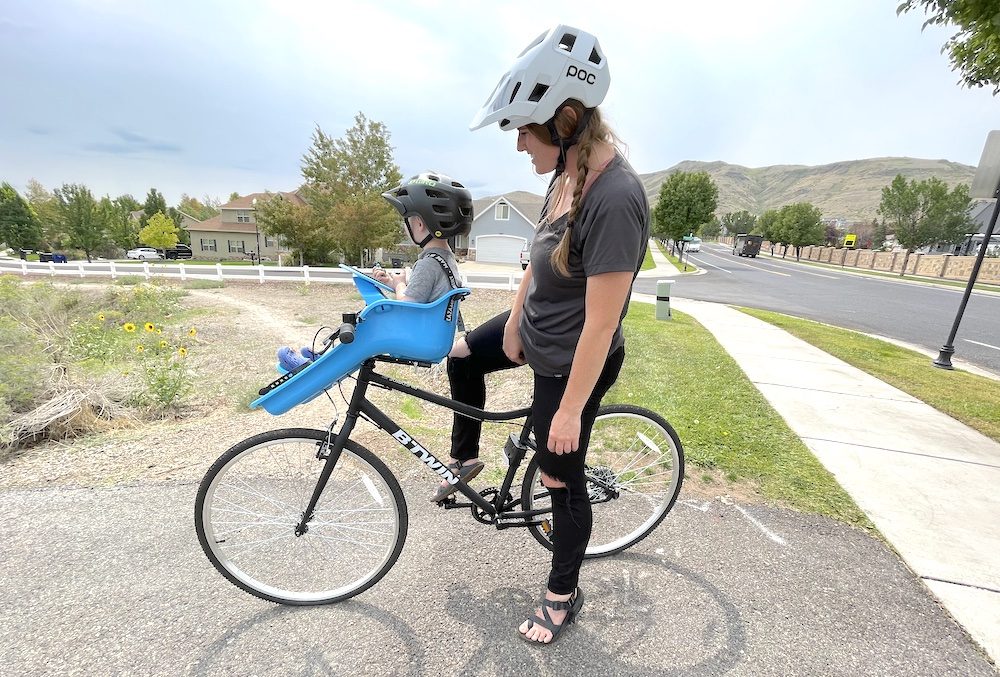
From bike compatibility, to ease of use and quality of build, in our review we’ll cover everything you need to know about the iBert before you click that buy button.
iBert Bike Seat Overview

RATING: Recommended
MSRP: $129
BEST FOR: Parents who want an easy-to-mount and easy-to-use front-mounted bike seat for shorter rides close to home
MOUNT TYPE: Front frame
AGE RANGE: 1 – 3 years (38 lb. max)
PROS:
- Compatible with threaded and most threadless headsets (not compatible with short stems)
- Easy and fast to install
- Padded “steering wheel” included
- Available in 6 different fun colors
- Takes up less room for the adult rider
CONS:
- Shoulder strap adjustments are difficult to do on the fly – iBert suggests adjusting them before you even put the seat on the bike
- Straps slide down even when properly tightened
- Sits higher on bike that other front-mounted seats, so it can negatively affect steering more
- Lap bar easily comes unsnapped with very little pressure applied
- Footrest height adjustments require tools
- Highest footrest setting is too low and foot straps way too long for the smallest of riders
- No back or neck support
iBert Bike Seat Review – Results of our Test Rides
As the iconic green and orange child bike seat, over the years the iBert has become the “go-to” child bike seat – it’s easily recognizable and comes highly recommended by many parents. We first had a chance to test out the iBert back in 2012, but with many changes and updates over the last few years, we decided it was time to take the updated iBert for a spin in 2021.
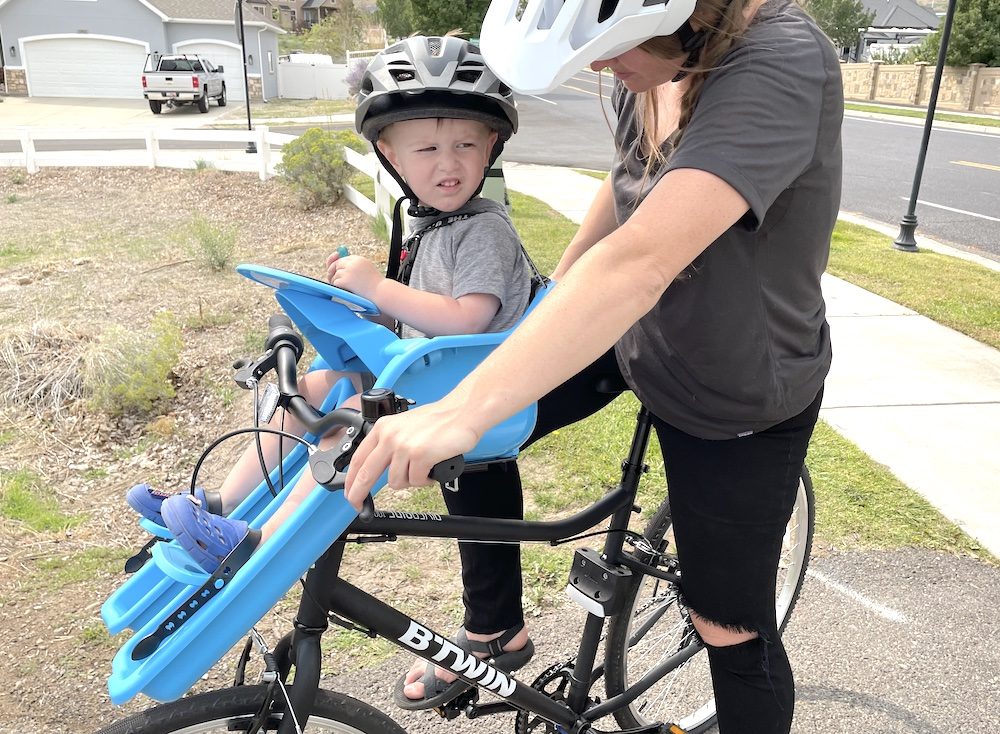
Kazam iBert vs. iBert Safe T Seat
One of the major changes to iBert was its transition from a small company to its acquisition by Kent Bicycles (the same Kent bicycles that sell in big-box stores). Kent also acquired Kazam balance bikes and now markets iBert under the Kazam name. As a result, the iBert is now officially known as the Kazam iBert child bike seat.
In addition to the name change, the iBert gained footrests, an upgraded mounting bar, as well as new color options.
iBert Performance
We put the iBert to the test around the neighborhood and on longer paved bike trails with our Two Wheeling Tots mom Lauren and her 25 lb., 2-year-old toddler. Having tested out the WeeRide as well as the Kids Ride Shotgun and MacRide front-mounted child bikes seats, Lauren certainly knows her way around front-mounted child bike seats.
All in all, she enjoyed riding with the iBert as she and her son shared fun and interactive rides exploring around town. Like all front-mounted seats, you can’t beat the closeness that parent and child experience while riding together and the iBert certainly delivers!

Getting comfortable on the iBert, however, did take some time. The previous seats she used (like the WeeRide) stay centered with the frame of the bike as you turn, while the iBert stays centered on the bike’s handlebars and moves as you move. (The iBert’s style is very common with front-mounted seats.)
Making this adjustment took some time, but for those who are already comfortable and confident on the bike, the transition shouldn’t be problematic. Many of our favorite front-mounted bike seats, like the Peg Perego Orion and the Thule Yepp Nexxt Mini also move with handlebars.
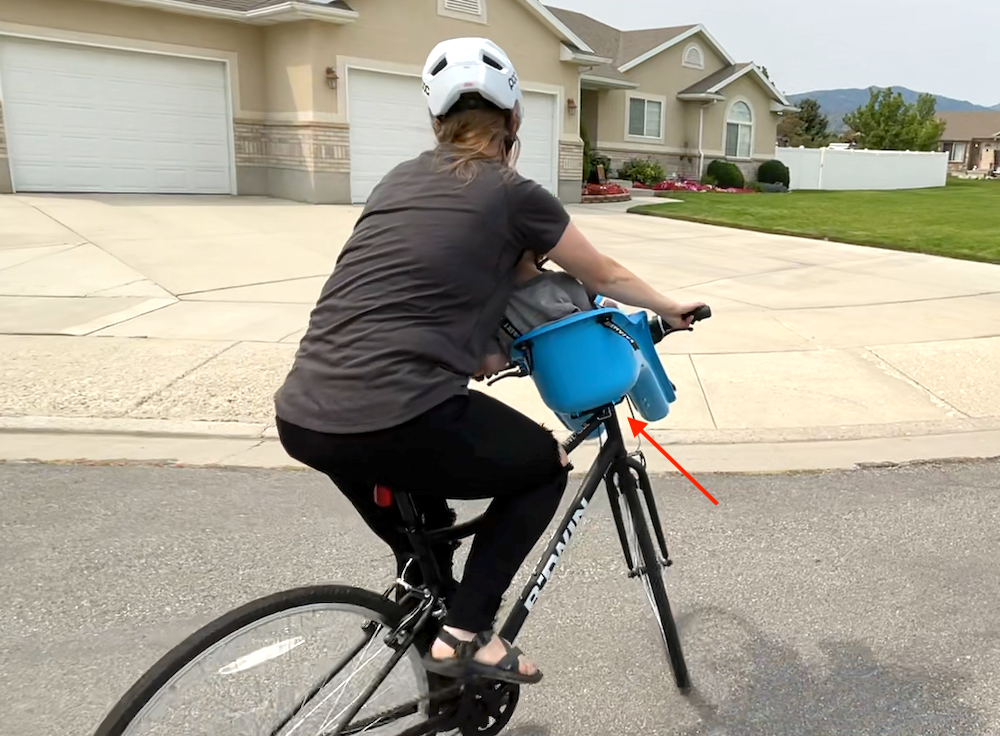
While out and about riding, one of the first things Lauren noticed compared to the WeeRide, was the iBert was positioned much higher on the bike. This higher-center of balance made starting and stopping a bit trickier, but certainly not a deal-breaker. (Once again, this is quite common with many of our favorite front-mounted seats.)
When starting and stopping, being extra careful to keep your hands on the handlebars is essential. When stopped with your feet down, if you don’t keep a hand on the handlebar, the front wheel on your bike can rotate on its own.
Upon doing so, the weight on the bike quickly shifts, which can catch you off guard. While we didn’t have any issues with the bike falling over, if you are new to front-mounted child bike seats, just make sure to keep those handlebars supported at all times.
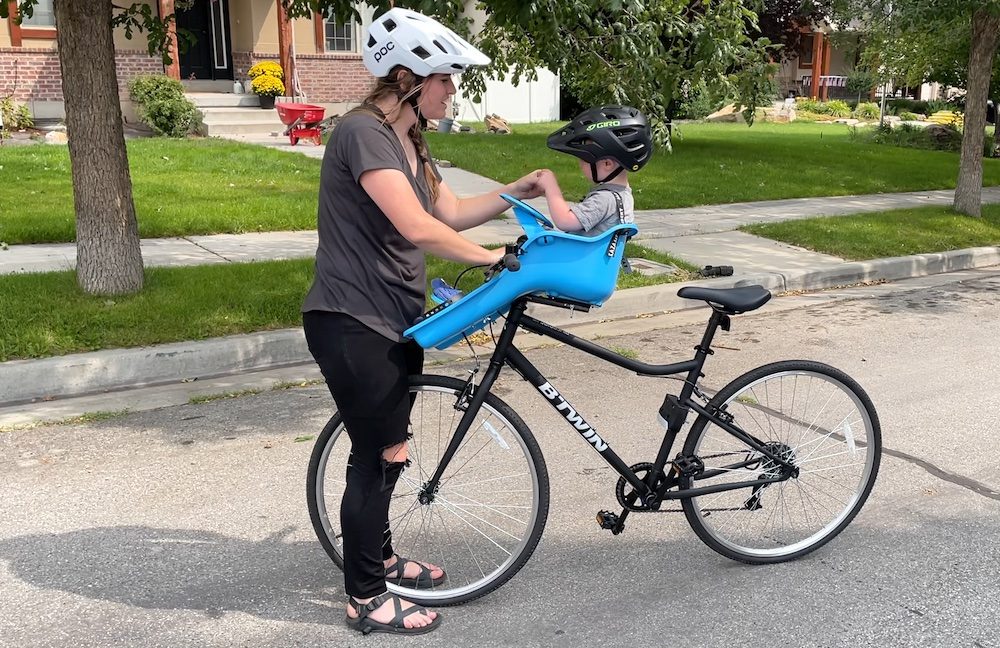
On the flip side, having the seat positioned higher does allow for more room for the adult rider. Unlike on the WeeRide, Lauren didn’t have to splay her legs nearly as much in order to pedal.

Without having to splay her legs out, Lauren was more comfortable while riding and didn’t hit her knees nearly as much as when riding with the WeeRide.

Upon hitting the trails for longer rides, the lack of splay was a plus, but the wobble of the seat (more explained below), become more cumbersome with time. Whether excited or restless, whenever her son shifted around his weight on the seat, the iBert would wobble back and forth.
While the wobble didn’t cause a loss of balance or appear to be a safety issue, it certainly put a damper on the ride as 25 lb. shifting consistently back and forth on your bike is less than ideal over a long period of time.

In the end, Lauren found the seat fun and easy to use, but certainly not her favorite. For short trips around the neighborhood, the iBert did just fine, but for longer trips, we prefer other front-mounted seats, such as the WeeRide or Thule Yepp Nexxt Mini.
Front-mounted or Rear-mounted seat?
The iBert child bike seat is a front-mounted bike seat that places the child rider in front of the adult rider versus behind. Front-mounted child bike seats are designed for small toddlers and all brands and models have a maximum weight of the child around 33 to 38 pounds.
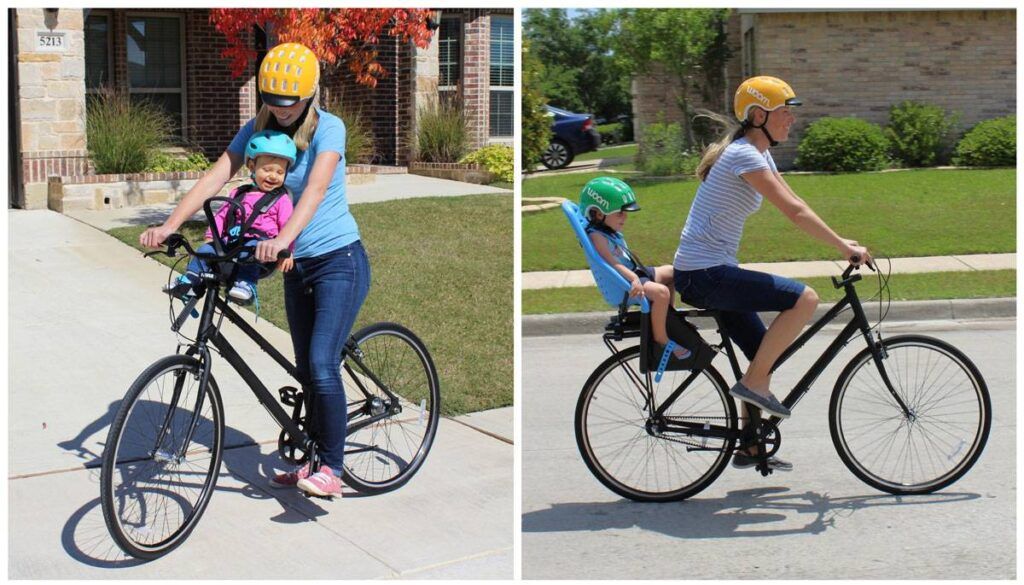
As a comparison, rear seats are larger and typically max out at 40 to 48.5 pounds, so their lifespan is much longer and they are better suited for kids older than 3.
Having used both styles of seats, our Mom testers here at Two Wheeling Tots are big fans of front-mounted seats with little toddlers as they allow you to share the ride with your child! Fun conversations and silly sing-alongs are commonplace on front-mounted seats.
With rear-mounted seats, in addition to not being able to see your child, it’s very difficult to have a conversation and “share” the riding experience with a child.
But front-mounted seats aren’t perfect. Front-mounted bike seats (including the iBert) can require the adult rider to splay their legs out in order to prevent their knees from hitting the back of the seat while pedaling.
The heads of taller kids (especially when riding with shorter parents) can bump into the chest of the adult rider. Overall, the space for the child and the adult rider is more limited with front-mounted seats.
With both front and rear-mounted bike seats, it’s important to keep in mind that there is a wide range of models and styles available. Some models of seats work much better with some bikes and riding styles than others.
So just because one particular model of seat doesn’t work for you doesn’t mean that another seat of the same type won’t work for you either. A complete rundown of our favorite seats can be found on our Best Child Bike Seats page.
What age child can ride on the iBert child bike seat?
The iBert’s recommended age range is 1 to 3 years or 38 lb. max. It is not recommended to place a child less than 1 year in the iBert as younger babies often do not have the neck strength to hold up their heads as well as a helmet while in the seat.
On the higher-end, be aware that many toddlers can weigh over 38 pounds pretty quickly. In fact, much to our surprise, the almost 3-year-old tester we originally planned to use for testing ended up weighing 44 lbs.!
Considering almost all front-mounted seats have a max weight capacity of 33 lb., if you have a heavier child, you will need to switch to a rear-mounted seat or explore “harness-free” front-mounted seats (more info on these on our Best Front-Mounted Bike Seats article).
Our main tester shown below, who just turned 2 and weighs 25 lb., was a great fit on the iBert. Not too big and not too small, he comfortably fits in the seat with room to grow.

In addition to being a good fit in the seat himself, he sat low enough in the seat so that 5’4″ mom had no troubles looking over him. With only a few inches between the top of his helmet and mom’s chin, you can easily see how a taller and larger child over 38 lb. would make for a tight fit on the iBert.

We also tested the iBert with a younger 15-month-old girl in size 12-month clothes. Being new to helmets, she was not willing to keep her helmet on, so our testing was extremely brief. With the exception of the footrests (more explained below), she also fit comfortably in the iBert.

Is the iBert compatible with my bike?
Front-mounted bike seats are notorious for bike compatibility issues. While there are many other features to consider when purchasing a child bike seat, compatibility is essential. If the seat doesn’t fit on your bike, nothing else really matters. While we did experience some fit issues with the iBert, compared to other seats, the iBert offers a pretty good universal fit on most adult bikes.
To fit on any bike, the iBert needs 3/4″ (~19mm) of space on the headset/stem (the “tube” beneath the handlebars). This applies to both threaded/quill stems (found on most cruiser or city-style bikes) and threadless headsets (found on most hybrid and mountain bikes).

Threaded (Quill Stem) Headsets
If your bike has a threaded quill stem headset (see picture below), the iBert is almost guaranteed to fit. If you don’t have 3/4″ of space, you will need to raise your stem by loosening the top bolt, pulling up on the handlebars, and then retightening the bolt. When doing so, make sure you don’t lift the quill stem (the tube being raised up) past its minimum insertion point.

While not related to the space on the bike, it is worth noting that cruiser styles bikes, which almost always have swept-back handlebars and quill stems, are compatible with the iBert. Considering many child bike seats, such as the WeeRide Kangaroo, are not compatible, the iBert is an excellent choice for cruiser-style bikes.

Threadless Headset
On bikes with threadless headsets, in addition to the 3/4″ of space, you will also need to check the length of your bike’s stem. Upon testing the iBert on several bikes, we found that the seat is not compatible with stems shorter than around 70 mm (more about this below).
To measure the length of your stem, simply measure from the center of your handlebars to the center bolt of the headset. The stem shown below is 70 mm in length.

Mounting the iBert to your Bike
Compared to other budget-friendly front-mounted seats, the iBert is very simple and easy to mount. The first step is to attach the black mounting bar to the headset via the two bolts. It’s a quick process.

Once the mounting bar is securely attached to the bike, you can now attach the seat to the mounting bar. The seat attaches to the mounting bar via three brackets on a mounting plate found on the bottom of the seat (shown below). The mounting bar slides through these three brackets.

A single locking pin is then inserted through the holes in the mounting bar as well as the center bracket (the one with the hole in it) of the seat.
The mounting bar has three holes to allow you to adjust how far forward the seat is positioned on the bike, but with all four bikes we tested the seat with, due to limited space, we had no choice but to use the last hole.
Due to the play in-between the mounting bracket on the base of the seat and the mounting bar, a properly mounted iBert is pretty wobbly. The seat easily and often tilts back and forth with or without a child on board.
Below are screenshots from a video we took of the iBert’s wobble with our 2-year-old tester onboard. If you compare the position of leg trays of the seat to the handlebars, you can see just how much the seat wobbles back and forth.

To be clear, the wobble is due to the play between the mounting bar and the mounting brackets. There is no way to “tighten” the seat in order to correct the wobble.
This wobbling was absolutely noticeable by our parent testers when riding. While not appreciated and a bit unnerving, the wobbling didn’t appear to be strong enough to be a safety risk.
Mounting Problems with Shorter Stems
The problem with shorter stems is that they limit the room available on the bike for the seat to mount. Shorter stems place the handlebars closer to the bike compared to bikes with longer stems.
As a result, when attempting to mount the iBert on a bike with a short stem, the seat hits the handlebars (preventing it from moving forward) before the mounting bar and brackets on the bottom of the seat are able to properly align.

For example, the image below was taken during our attempt to mount the iBert on a modern mountain bike with a shorter 45 mm stem. The seat is pushed forward as much as possible (so that the seat is hitting the handlebars), but the last bracket is not yet able to make contact with the mounting bar. This makes the seat incompatible with the bike.

On our mountain bike with a 70mm stem, however, there was sufficient room for the seat to slide forward enough on the mounting bar for all of the brackets to make contact with the bar so that the locking pin could be inserted.

Removing the iBert from your Bike
When the seat is not in use on the bike, the mounting bar should be removed to ensure the safety of the rider. By loosening one bolt and removing the other, the mount can quickly and easily be removed.
While removing the seat and the mounting bar are not hard or too time-consuming, it is not considered to be a “quick-release” seat. Quick-release seats allow you to quickly remove the seat from the bike with a push of a button. Within seconds, a seat like that is removed and a small and unobtrusive bracket remains behind on the bike.

For those who plan on regularly riding the same adult bike with and without the iBert attached, a quick-release seat is pretty dang nice to have, but not essential. Similarly priced seats such as the Peg Perego Orion and Hamax Observer feature quick-release brackets that are much more compact and easier to use.
Adjusting the iBert to Fit Your Child
As any parent of a toddler knows, the ease of adjusting the straps in a car seat or stroller can quickly put you at ease or bring on much frustration. Likewise, squirmy and excited toddlers can be a challenge to buckle into a child bike seat.
As a result, we love, love, love child bike seat straps that are easy to adjust. Unfortunately, the iBert’s straps are not very easy to adjust, but iBert did come up with a creative solution that helps the process.
In order to adjust the straps on the iBert, they suggest fitting the straps to the child BEFORE you mount the seat to the bike. To do so, place the seat down on the ground (preferably on carpet) and have the child sit in the seat. While they are seated, begin threading, loosening, and readjusting the straps to ensure a good fit.
Steps for Adjusting Straps
First, adjust the length of the bottom strap to make sure the top of the buckle is located 2 inches below your child’s chin when they are sitting up.
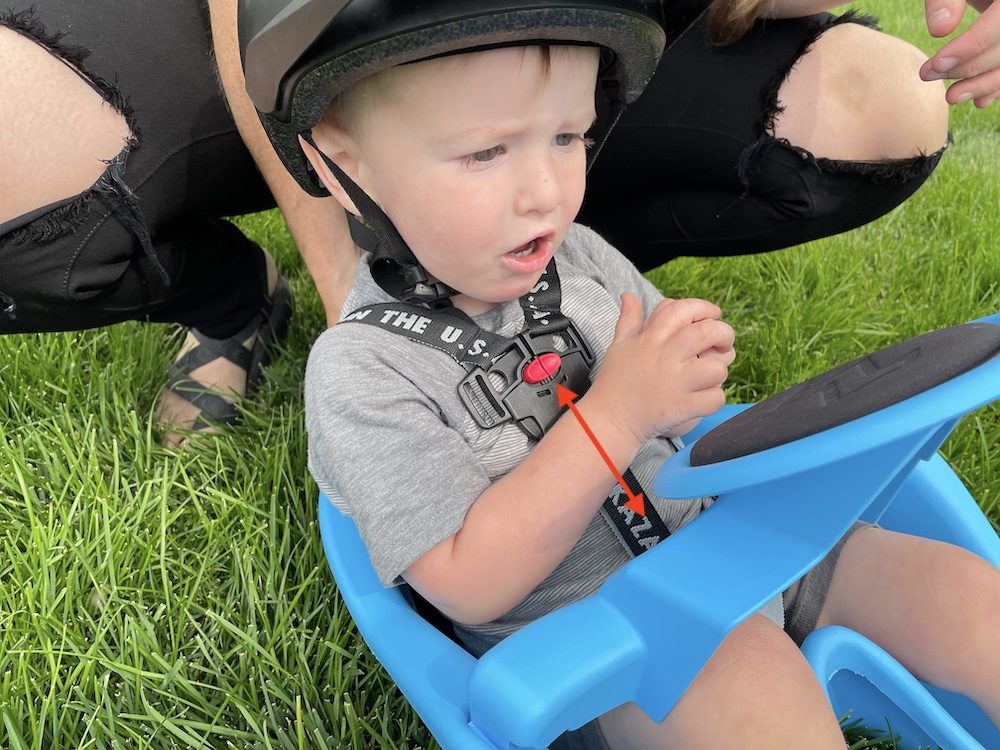
Next, adjust the shoulder straps to ensure a tight fit when the child is leaning back in the chair.

As the child grows it is important to continually adjust the straps of the iBert to ensure a proper fit. If the buckle is not placed high on the child, the straps are much more likely to slide down off the child’s shoulders during a ride. Then again, based on our experience, the shoulders straps on the iBert tend to slide off frequently, even when the straps are properly adjusted.

Low-back Seat
One of the main reasons the straps slide off is due to the low seat back of the iBert. Unlike car seats and strollers, the height of the iBert’s insertion point of the shoulder straps is fixed and cannot be adjusted. As a result, the straps have to go all the way up and over a child’s shoulders unsupported before they reach the buckle on the front of the child.
This long journey often leads to the straps falling or slipping down. Properly adjusting the center buckle to be 2″ below the child’s chin certainly does help, but doesn’t prevent the straps from falling off.
To be fair, most front-mounted child bike seats also do not have adjustable shoulder strap insertions points, but they do have higher backs, which greatly reduces the distance the strap has to travel unsupported.
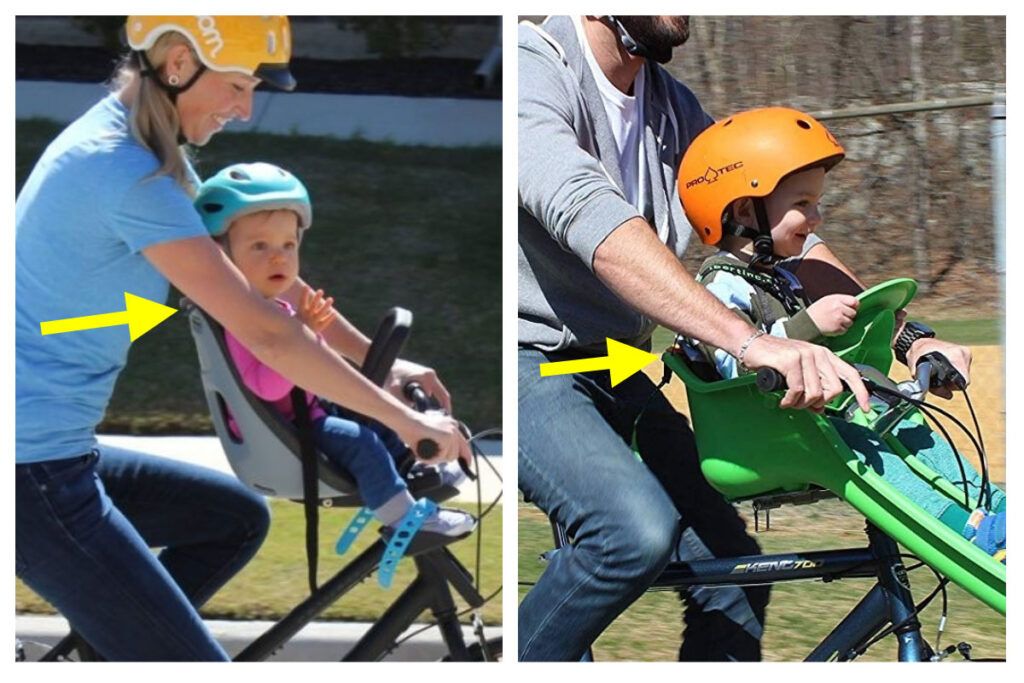
Lap Bar with Steering Wheel
While taking the time to adjust the shoulder straps on the iBert is time-consuming, it is essential as the lap bar on the iBert is NOT designed to keep your child in place while in the seat.
While the lap bar does snap into place, it easily and quickly “unsnaps” if the child puts any pressure on the circle steering wheel. As you can see in the image below, the steering wheel is also quite flexible and easily bends with the slightest pressure applied to it.

During a longer ride, our two-year-old tester figured this out, which quickly became problematic as he learned how to lift up the steering wheel and lap bar! Clearly not safe for the child and the adult rider. If your child figures out how to unhook the steering wheel by pushing down on it, we recommend just removing it and riding without it.

The steering wheel comes with a pad designed for a sleepy child to rest their head during a ride, but our 15-month-old tester quickly ripped it off within minutes of being in the seat, so don’t plan on it sticking around.
Additionally, considering how flexible the steering wheel is, its usefulness is pretty limited for sleepy kids. Since the steering wheel flexes downward, the child’s shoulder straps would have to be pretty loose for their head to rest on the pad.

Footrest Tray
In an attempt to keep your little one’s legs and feet secure during the ride, the iBert has “leg trays” along with a height-adjustable footrest and ankle strap. The leg trays work as great support for little legs, but we found the foot trays and ankle strap to be harder to use than other brands.
Our main concern with the foot tray is that it didn’t go up high enough to be supportive for our 18-month-old tester. In its highest position, her foot couldn’t reach the base of the footrest, which also made the ankle strap worthless.

The ankle straps, however, worked great in keeping our 2-year-old tester’s feet secure. Considering he was only 13 pounds lower than the maximum weight limit of the seat and the footrests still needed to be positioned in the highest setting, it is very unlikely that the lower positions of the footrest would ever be useful.

Unlike other brands, the foot trays on the iBert are not “quick release” and require removing and replacing four bolts to adjust the height of both trays. Considering how quickly kids grow, being able to quickly adjust the height for a proper fit is certainly a bonus that the iBert doesn’t have.
In the image below you can see the iBert’s “screws required” design versus Thule’s “quick release design”.

iBert Safe T Seat Updates from Previous Models
Considering many Amazon listings of the iBert have years of reviews, it’s important to point out which features have been updated and which have not.
Updated Mounting Bar
As of 2021, the mounting bar of the current iBert is solid black, while the previous version was silver. There were several reports of the silver mounting bar breaking (our’s never did), but we have yet to hear of any report of the newer black version breaking.
New Colors
The iBert was originally only offered in green with orange padding. Pink was later added and now the seat is also available in blue, teal, and light and dark grey.
Included Steering Wheel and Footrests
The original iBert did not come with the steering wheel attachment or with foot trays. The steering wheel was later offered as an add-on but is now included with every seat. While the iBert always featured the leg trays, the adjustable foot trays with ankle straps were later added.
iBert vs. Competitors
We’ve tested 19 front-mounted child bike seats, and while the iBert is certainly a fun and unique seat, it does have limited features compared to similarly priced (or even cheaper) front-mounted bike seats.
The main difference between the iBert and other seats that are in its price range is its additional 5 lb. weight capacity. While we aren’t sure what contributes to its higher weight rating (there are no official testing standards for front seats), the lower back and more “open” style of the iBert does allow it to fit a slightly larger child compared to the Peg Perego and the Hamax Observer.
| iBert | Peg Perego Orion | Hamax Observer | |
| MSRP | $130 | $95 | $139 |
| Max Weight | 38 lb. | 33 lb. | 33 lb. |
| Space for Mount | 3/4″ on headset | none – mounts to headtube | 1.9″ on headset |
| High back for support | No | Yes | Yes |
| Quick Release Seat | No | Yes | Yes |
| Easy-adjust shoulder straps | No | No | Yes |
For a complete run-down, be sure to check out our Best Front-mounted Child Bike Seats List.
iBert Child Bike Seat Bottom Line
For around-town, the iBert is a fun, interactive seat that your child is sure to love. With a recommended maximum child weight capacity being 5 lb. heavier than other brands, the iBert offers ample room for growth.
Compared to similarly priced front-mounted seats, however, the iBert is pretty basic. Its less-than-awesome shoulder strap design and wobbly seat mount are pretty disappointing considering its higher price point.
All in all, if you are looking for a fun seat for short rides around the neighborhood, the iBert is certainly up for the job. But before your purchase, be sure to check out our Best Child Front-mounted Bike Seats page to see other highly recommended options that are similar in price or less expensive than the iBert.
FTC Disclosure: Affiliate links are included in this review. No monetary compensation was provided for this review. The product reviewed was supplied by the manufacturer to facilitate this review. All opinions and images are that of Two Wheeling Tots LLC. All content and images are copyrighted and should not be used or replicated in any way. View our Terms of Use.
